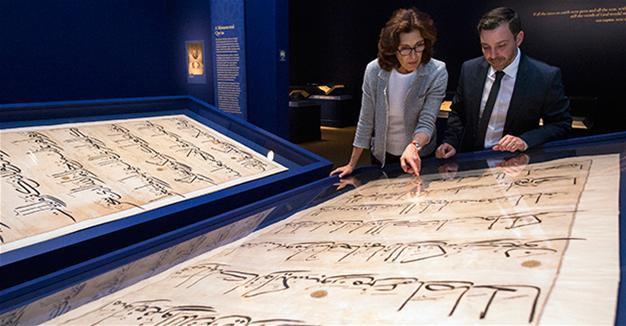US Quran exhibit visitors view display with hope
WASHINGTON – Anadolu Agency

In this photo taken Oct. 20, 2016, Massumeh Farhad, left, and Simon Rettig, curators of the exhibit "The Art of the Qur'an: Treasures from the Museum of Turkish and Islamic Arts," look at pages from a 5-foot by 7-foot Quran displayed as part of the exhibit at the Sackler Gallery in Washington. AP photo
Some of the first visitors at a newly opened Quran exhibition on Oct. 22 said they hoped the display would help overcome prejudice and spread awareness about Islam.“This exhibit will really help bring people together and it represents how much Islam has to offer American culture,” said Doug Kempner, a 26-year-old from Washington D.C.
He added that Quranic art was “just so beautiful and the Turkish museum has so much to offer. It’s so amazing that it’s here in the U.S.”
The exhibition at the Freer Gallery of Art and the Arthur M. Sackler Gallery – both part of the Smithsonian Institution – features 47 handwritten Qurans from the Museum of Turkish and Islamic Arts in Istanbul, in addition to 18 Qurans from the Freer and Sackler permanent collections.
The holy books themselves come from a wide geographic area spanning Turkey to Afghanistan and cover almost 1,000 years of history from the eighth century, years after the Prophet Muhammad’s death, to the 17th.
Many of the manuscripts are on display outside of Turkey for the first time.
“We try to read the Quran on a daily basis but understanding the history behind it and how it ties into different cultures, different civilizations that have used it throughout the years – it’s just amazing,” said Ashequl Hoque, a 37-year old Maryland resident.
Hoque, who was visiting with his wife and two children, all Muslims, added: “We feel just as hijacked as anybody by what the terrorists are doing with the religion. The more that people can understand and appreciate the deeper meanings of the Quran and the peaceful messages that come out of it, I’m hopeful that will help permeate through the community and drive some of the unity that we’re lacking right now.”
Anam Whyne, 29, of Washington D.C., said the exhibit was a welcome deviation from anti-Muslim sentiment.
“It kind of makes it more real and human when you look at just the history and what’s going on instead of kind of tainting it and coming with biases to it,” she said. “I’m really hopeful. I am glad that they did this here.”

















